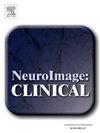对侧前额叶和网络参与左DLPFC 10hz rTMS:在健康成人的交叉TMS-fMRI研究
IF 3.6
2区 医学
Q2 NEUROIMAGING
引用次数: 0
摘要
高频重复经颅磁刺激(rTMS)在左背外侧前额叶皮层(DLPFC)是一种有效的治疗重度抑郁症和其他精神疾病。尽管其临床应用越来越广泛,但前额叶rTMS发挥其治疗效果的神经机制仍不完全清楚。为了解决这一差距,我们使用交错TMS-fMRI研究了健康个体左DLPFC在600次10hz rTMS刺激期间的即时血氧水平依赖性(BOLD)活动。方法采用交叉设计,17名健康受试者在mri内分别以静息运动阈值(rMT)的40%和80%接受10 Hz rTMS(60组,间隔9秒)。结果10hz rTMS在左侧DLPFC诱发了前额叶区、扣带皮层、脑岛、纹状体、丘脑以及听觉和体感区的BOLD反应。值得注意的是,我们的研究结果显示,10hz rTMS效应向对侧(右侧)DLPFC侧化。40%和80% rMT之间的剂量-反应效应仅在海马体中观察到。结论本研究采用的10hz rTMS方案在前额皮质诱导了不同的目标接触和传播模式。这些模式不同于我们之前使用600次相同强度的左DLPFC间歇性θ波爆发刺激(iTBS)的TMS-fMRI交错结果。因此,交错TMS-fMRI作为一种有价值的方法,可以比较临床前额叶rTMS方案对脑回路的直接影响,以区分其作用机制,并可能为临床应用提供信息。本文章由计算机程序翻译,如有差异,请以英文原文为准。
Contralateral prefrontal and network engagement during left DLPFC 10 Hz rTMS: an interleaved TMS-fMRI study in healthy adults
Background
High-frequency repetitive transcranial magnetic stimulation (rTMS) over the left dorsolateral prefrontal cortex (DLPFC) serves as an effective treatment for major depression and other psychiatric disorders. Despite its growing clinical application, the neural mechanisms by which prefrontal rTMS exerts its therapeutic effects remain incompletely understood. To address this gap, we investigated the immediate blood-oxygen-level-dependent (BOLD) activity during 600 stimuli of left DLPFC 10 Hz rTMS in healthy individuals using interleaved TMS-fMRI.
Methods
In a crossover design, 17 healthy subjects received 10 Hz rTMS (60 trains with 9-second intertrain intervals) over the left DLPFC at 40 % and 80 % of their resting motor threshold (rMT) inside the MR scanner.
Results
10 Hz rTMS over the left DLPFC elicited BOLD responses in prefrontal regions, cingulate cortex, insula, striatum, thalamus, as well as auditory and somatosensory areas. Notably, our findings revealed that 10 Hz rTMS effects were lateralized towards the contralateral (right) DLPFC. Dose-response effects between 40 % vs. 80 % rMT were exclusively observed in the hippocampus.
Conclusions
The 10 Hz rTMS protocol used in this study induced distinct target engagement and propagation patterns in the prefrontal cortex. These patterns differ from our previous interleaved TMS-fMRI findings using 600 stimuli of left DLPFC intermittent theta burst stimulation (iTBS) at the same intensities. Thus, interleaved TMS-fMRI emerges as a valuable method for comparing clinical prefrontal rTMS protocols regarding their immediate effect on brain circuits in order to differentiate their action mechanisms and to potentially inform clinical applications.
求助全文
通过发布文献求助,成功后即可免费获取论文全文。
去求助
来源期刊

Neuroimage-Clinical
NEUROIMAGING-
CiteScore
7.50
自引率
4.80%
发文量
368
审稿时长
52 days
期刊介绍:
NeuroImage: Clinical, a journal of diseases, disorders and syndromes involving the Nervous System, provides a vehicle for communicating important advances in the study of abnormal structure-function relationships of the human nervous system based on imaging.
The focus of NeuroImage: Clinical is on defining changes to the brain associated with primary neurologic and psychiatric diseases and disorders of the nervous system as well as behavioral syndromes and developmental conditions. The main criterion for judging papers is the extent of scientific advancement in the understanding of the pathophysiologic mechanisms of diseases and disorders, in identification of functional models that link clinical signs and symptoms with brain function and in the creation of image based tools applicable to a broad range of clinical needs including diagnosis, monitoring and tracking of illness, predicting therapeutic response and development of new treatments. Papers dealing with structure and function in animal models will also be considered if they reveal mechanisms that can be readily translated to human conditions.
 求助内容:
求助内容: 应助结果提醒方式:
应助结果提醒方式:


